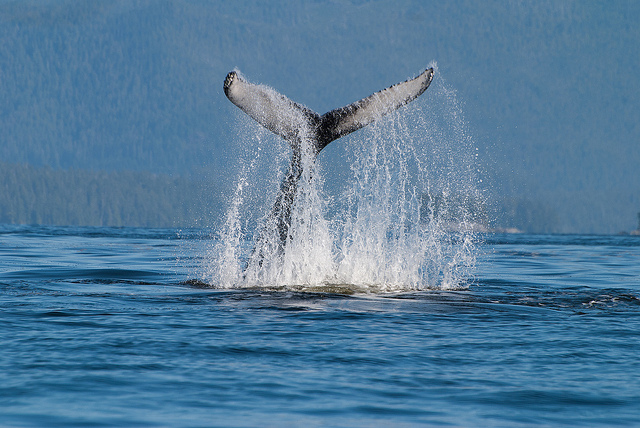
Canadians love parks and wilderness. Environment Minister Catherine McKenna recently said the most popular item in the federal budget was free admission for Canadians to all national parks in 2017, to mark Canada’s 150th birthday.
Banff, Nahanni, Algonquin, Gros Morne – these names are etched in our consciousness. Yet we’re less familiar with the grandeur and ecological wonders of Canada’s ocean world. It’s time to make a splash and make Canadians proud of this essential part of our natural heritage and life support system.
Marine protected areas (MPAs) are gaining traction around the world as scientists and policymakers respond to signs that our oceans are in declining health with recognition that more thoughtful stewardship of our oceans is required. Among the new Sustainable Development Goals (SDGs) adopted in 2015, the UN has issued a call to “[c]onserve and sustainably use the oceans, seas and marine resources for sustainable development”. To attain this goal, it has established 7 targets to be reached over the next 5-10 years, including the protection of over 10% of marine and coastal areas by 2020. The oceans SDG mirrors Aichi Target 11 adopted under the Convention on Biological Diversity, which also references the 10% by 2020 target.
Canada’s new government has committed to protecting 5% of its marine and coastal area by 2017, with an aim of reaching 10% by 2020, in line with these targets. We need to get moving: at present, only 1.3% of Canadian territorial waters are protected.
We lag behind many other nations in securing effective protections for our marine waters.
Consider these examples:
- Australia completed has the world’s largest network of marine reserves in record time. Meeting our MPA target will require similarly swift action. The Great Barrier Reef Marine Park is perhaps the world’s best known example of a large MPA. About one third of the park is covered by no-take zones (i.e., areas without consumptive withdrawal rights).
- In California, the extensive MPA network comprises approximately 60% of all no-take MPAs in the waters of the continental US.
- The wildly diverse Member States of the European Union were able to agree on increasing the proportion of MPAs to 5.9% of the Union’s waters as of 2012.
- Last year, the tiny island nation of Palau created one of the world’s largest marine sanctuaries. The Palau National Marine Sanctuary Act limits commercial fishing and other extractive activities in approximately 80% of the nation’s exclusive economic zone. Palauans have a traditional marine conservation practice called “bul,” which declares an area as a no-take zone or no-fishing zone. Their new law incorporates this customary law.
- New Ecuadorean regulations prohibit fishing in many parts of another iconic ocean area: the Galápagos Marine Reserve. Though this World Heritage Site did not allow industrial fishing, smaller-scale fishing was still permitted until recently. A recent decree designates about a third of the entire Reserve as a no-take zone in which fishing, drilling and mining are prohibited.
- The UK, meanwhile, designated 23 new Marine Conservation Zones this year, fulfilling a mandate under its Marine and Coastal Access Act 2009. Protected areas now cover 20% of English waters, up from only 6% in 2012.
Many countries are moving swiftly with new MPA designations. New Zealand is consulting on a new marine protected areas law to move from its current marine reserve holdings of 0.29% to reach the globally agreed 10% target. NZ has also introduced a bill into Parliament to protect the Kermadec Ocean Sanctuary, a massive area in the South Pacific which accounts for over 15% of its exclusive economic zone, with complete bans on commercial and recreational fishing, and oil, gas and mineral prospecting, exploration and mining. South Africa recently proposed 22 new MPAs to increase ocean protection coverage to more than 5%, a dramatic increase from the current level of 0.5%.
Canada has a lot to learn from these examples.
The Standing Committee on Environment and Sustainable Development is conducting a study on federal protected areas looking at how the full range of federal protected areas can work together to achieve both international conservation targets and domestic legislative objectives. The conclusions of this discussion will help shape government policy towards conservation areas in the critical years to come.
As part of this process, WCEL has submitted a brief on marine protected areas, and will offer evidence before the committee May 17th.
In light of the successful experiences of other nations, WCEL recommends a range of legislative reforms to help reach the goal of 10% marine protection by 2020. These reforms include both designating areas and ensuring that protection is robust. They include linking various agencies together to permit a comprehensive approach to marine protection, creating new legal protections for zones identified by existing processes like the Marine Plan Partnership (MaPP), incorporating systems of Indigenous co-management and co-governance, and setting minimum levels of protection for conservation areas based on international standards.
Better laws will not only facilitate the creation of new protected areas, but ensure that these areas are more effectively protected and managed.
Canada may be off to a slow start compared to other nations, but there is still time to catch up.
By Linda Nowlan, Staff Counsel